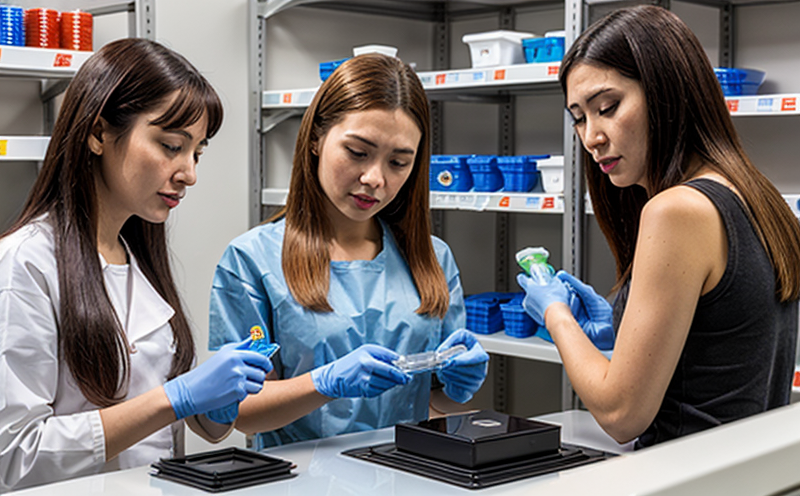ASTM D543 Chemical Resistance Testing of Consumer Plastic Materials
The ASTM D543 standard specifies the procedure for determining the resistance to chemical attack in flexural stress, modulus, and deflection temperature range (DTR) of plastic materials. This service is particularly relevant for consumer plastics that must withstand exposure to various chemicals during their lifecycle. Understanding how these materials perform under such conditions ensures product durability, safety, and compliance with international standards.
This testing is crucial in sectors like packaging, automotive interiors, household appliances, and electronic devices where plastics are used extensively. The chemical resistance of a plastic material can significantly impact its performance, especially when exposed to solvents, detergents, or cleaning agents. ASTM D543 provides a standardized approach to assess the long-term reliability of these materials by simulating real-world conditions.
The test involves placing specimens made from different types of consumer plastics into a solution containing specified chemicals. The specimens are then subjected to flexural stress and modulus testing under defined temperature conditions. After exposure, the samples undergo further mechanical tests to evaluate any changes in their properties due to chemical interaction. Compliance with this standard is essential for manufacturers aiming to ensure product integrity and avoid potential recalls or safety issues.
For quality managers and compliance officers, knowing that a supplier's products meet ASTM D543 standards can provide assurance about the materials' suitability for intended applications. R&D engineers benefit from detailed test results that guide material selection and formulation. Procurement teams also find value in this service as it helps them source suppliers who adhere to rigorous testing protocols.
The ASTM D543 test procedure is widely recognized by industry leaders, regulatory bodies, and international standards organizations. By ensuring compliance with this standard, manufacturers can demonstrate their commitment to quality and safety, thereby enhancing customer trust and satisfaction.
Key Parameters: Flexural strength, modulus of elasticity, deflection temperature range (DTR), chemical exposure time, and temperature conditions are critical factors in ASTM D543 testing. Specimens prepared from various types of consumer plastics undergo these tests to evaluate their resistance to chemical attack.
Real-World Application: This test is particularly important for plastic components used in household appliances like dishwashers, washing machines, and refrigerators, where exposure to cleaning agents and water is inevitable. Similarly, automotive interior parts exposed to solvents and detergents during manufacturing and use benefit from this testing.
Scope and Methodology
| Test Type | Flexural Stress, Modulus of Elasticity, Deflection Temperature Range (DTR) |
|---|---|
| Materials Tested | Consumer Plastics like PP, PE, PVC, ABS, etc. |
| Chemical Exposure | Detergents, Solvents, Cleaning Agents, and Similar Substances |
| Temperature Conditions | -25°C to 100°C (Optional: -40°C to 135°C) |
| Test Specimen Preparation | Cylindrical specimens with specified dimensions and thickness. |
|---|---|
| Chemical Exposure Time | 7 days or as per customer requirements. |
| Mechanical Testing | Flexural strength, modulus of elasticity, deflection temperature range (DTR). |
| Data Analysis | Difference in mechanical properties before and after chemical exposure. |
The testing procedure begins with the preparation of cylindrical specimens from different types of consumer plastics. These specimens are then immersed in a solution containing specified chemicals for a defined period (usually 7 days). After exposure, they undergo flexural stress, modulus of elasticity, and deflection temperature range tests to measure changes in mechanical properties.
Temperature conditions can vary depending on the specific requirements of the customer or regulatory standards. For instance, some applications may require testing at lower temperatures (-25°C) while others might need higher ranges (100°C). The optional extended range (-40°C to 135°C) allows for more comprehensive evaluation of material performance under extreme conditions.
Following the mechanical tests, data analysis focuses on identifying any significant differences in flexural strength, modulus of elasticity, and deflection temperature range before and after chemical exposure. This information is critical for determining the suitability of a particular plastic type for specific applications within consumer goods industries.
Customer Impact and Satisfaction
The ASTM D543 chemical resistance testing service significantly impacts customer satisfaction by ensuring product reliability, safety, and compliance with international standards. For quality managers and compliance officers, this service offers peace of mind knowing that suppliers adhere to rigorous testing protocols.
R&D engineers can rely on detailed test results to guide material selection and formulation processes, leading to innovative product designs that meet both performance expectations and regulatory requirements. Procurement teams benefit from sourcing suppliers who demonstrate commitment to quality through adherence to ASTM D543 standards.
By ensuring compliance with this standard, manufacturers enhance their reputation for delivering high-quality products that are safe and reliable throughout their lifecycle. This approach fosters customer trust and satisfaction, ultimately contributing to brand loyalty and market competitiveness.
Moreover, compliance with ASTM D543 helps avoid potential issues such as product recalls due to material failure or non-compliance with safety regulations. It also facilitates smoother interactions with regulatory bodies during audits or inspections, reducing the risk of delays or penalties.
International Acceptance and Recognition
The ASTM D543 chemical resistance testing service is widely accepted and recognized by industry leaders, regulatory bodies, and international standards organizations. This standard has been adopted globally to ensure consistent quality and performance of consumer plastics across various applications.
Many countries have incorporated ASTM D543 into their national regulations or guidelines for plastic material specifications. For instance, the European Union's Directive on Packaging and Packaging Waste (2019/090/EU) references this standard to assess chemical resistance properties of packaging materials used in consumer goods.
Similarly, organizations like the International Organization for Standardization (ISO) have acknowledged ASTM D543 as a reliable method for evaluating plastic material performance. Compliance with this standard is thus seen as an indicator of adherence to international best practices and quality standards.
This widespread acceptance enhances confidence among customers, suppliers, and regulatory authorities alike. It also facilitates seamless trade between countries by ensuring that products meet accepted benchmarks regardless of geographical location.





